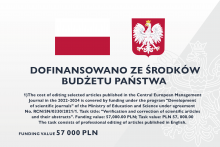Purpose: Interest in older consumers as the subject of marketing strategy is growing in Western countries (Gunter, 1998). However, in Poland, this group is still neglected by marketers and perceived in stereotypical way, and its marketing potential is underestimated. The main goal of this research was to provide understanding of the contemporary older Polish population and especially older Polish consumers, including their values, needs,
attitudes, opinions and behaviors.
Methodology: In order to investigate the Polish “grey market,” we conducted survey research (CAPI) based on a representative quota – a random nationwide sample of n=1500 participants above 55 years old. Additionally, we also conducted qualitative research – 18 individual in-depth interviews (IDIs) at homes of consumers (ethnographic interviews).
Findings: Based on the factor and cluster analysis (Weinstein, 1994) from the quantitative survey, 5 segments of older Polish consumers were selected: Fulfi lled Optimists (14% of population), Bored with Life (17%), Passive Materialists (22%), Family-oriented Non-Paterialists (22%), and Excluded Traditionalists (25%). Segments differed in values, lifestyles, attitudes toward life, family, work and general life satisfaction. As a consequence of those psychological differences, segments differed in consumer behaviour, preferences and perception of marketing communication (advertising).
Originality: Our analysis shows that key areas, which determine particular consumer behaviour in each segment are – contrary to common belief – not demographic characteristics, but mainly psychological aspects (such as attitude to life, optimism, attitude to money, open-mindedness and general curiosity).





